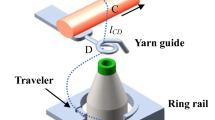Abstract
Siro-spinning is a new kind of modified ring spinning method and achieved by feeding two rovings simultaneously, which have three spinning triangles including two primary spinning triangles and one final spinning triangle. In this paper, by using finite element method (FEM), the quantitative relationships between the fiber tension in the Siro-spinning triangle and some chosen important spinning parameters are investigated. The constituent fibers in the Siro-spinning triangle are considered as three-dimensional elastic beam elements with tensile, compressive, torsion, and bending capabilities. Then, the finite element model of Siro-spinning triangle is constructed under the assumption that the ends of all fibers gripped in the front roller nip distribute evenly, and the initial strain of the central fiber in each primary triangle is set as zero. Finally, the effects of some more important parameters of the Siro-spinning triangle, including the spinning yarn count, spinning tension, yarn twist, the distance between two feeding bell mouths on fiber tension distributions, are numerically examined and their quantitative relationships are discussed in detail. The accuracy of the proposed FEM model in calculating the fiber tension distribution of the Siro-spinning triangle has been validated by comparing it with our earlier theoretical models. Furthermore, the spinning experiments with different progress parameters were made, and the properties of spun yarns were evaluated and analyzed.
Similar content being viewed by others
References
M. N. Sun and K. P. S. Cheng, Text. Res. J., 70, 261 (2000).
X. J. Liu and X. Z. Su, J. Text. Inst., 104, 473 (2013).
J. H. He and L. N. Zhang, Text. Res. J., 78, 1022 (2008).
J. H. He, Fibres Text. East. Eur., 15, 31 (2007).
T. Hua, X. M. Tao, K. P. S. Cheng, and B. G. Xu, Text. Res. J., 77, 853 (2007).
T. Hua, X. M. Tao, K. P. S. Cheng, and B. G. Xu, Text. Res. J., 80, 116 (2010).
J. Feng, B. G. Xu, X. M. Tao, and T. Hua, Text. Res. J., 80, 1456 (2010).
K. P. S. Cheng and M. N. Sun, Text. Res. J., 68, 520 (1998).
S. Y. Li, B. G. Xu, and X. M. Tao, Text. Res. J., 81, 959 (2011).
N. S. Shaikhzadeh, “An Analysis of the Twist Triangle in Ring Spinning”, Ph.D. Thesis, University of New South Wales, New South Wales, 1996.
H. You, J. K. Hyung, and S. K. Jong, Fiber. Polym., 9, 349 (2008).
C. P. Xie, J. K. Wang, and B. J. Xu, “Spinning Engineering”, 1st ed., pp.370–380, China Textile Press, Beijjing, 2012.
A. R. Kalyanaraman, J. Text. Inst., 83, 407 (1992).
L. D. Cheng, P. H. Fu, and X. Y. Yu, Text. Res. J., 74, 763 (2004).
K. Yang, X. M. Tao, B. G. Xu, and L. Jimmy, Text. Res. J., 77, 675 (2007).
Author information
Authors and Affiliations
Corresponding author
Rights and permissions
About this article
Cite this article
Liu, X., Liu, N., Su, X. et al. Numerical analysis of fibers tensions in the Siro-spinning triangle using finite element method. Fibers Polym 16, 209–215 (2015). https://doi.org/10.1007/s12221-015-0209-4
Received:
Revised:
Accepted:
Published:
Issue Date:
DOI: https://doi.org/10.1007/s12221-015-0209-4




